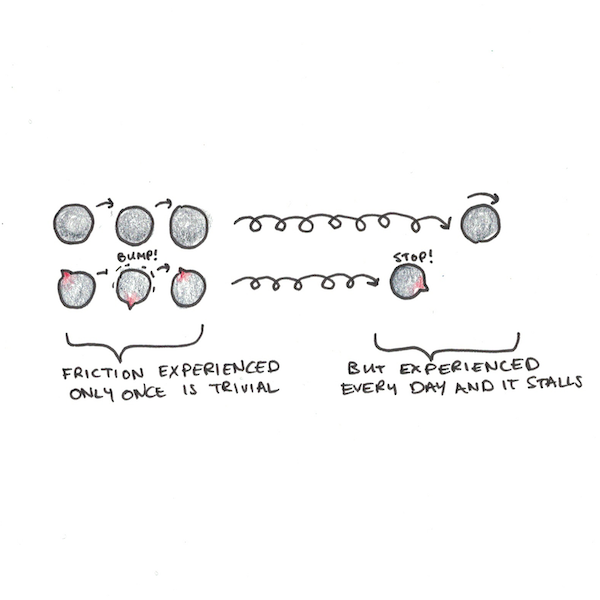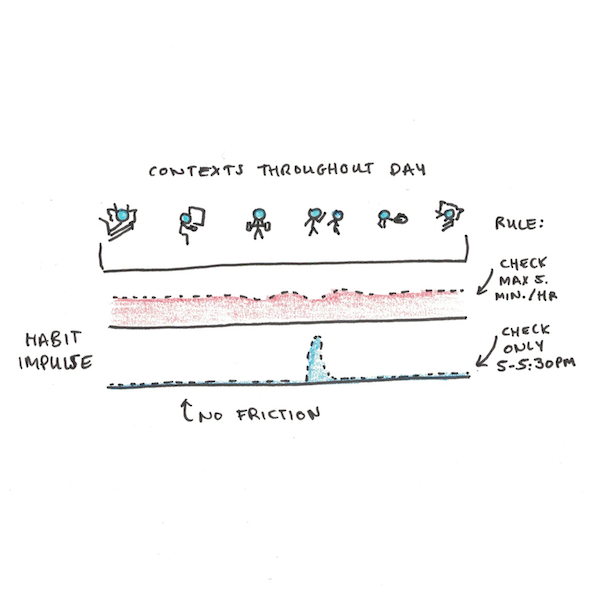This week, in anticipation of the second session of Life of Focus, I’ve been sharing lessons about centering your life back onto what matters. For those who missed the previous lessons, check them out here.
Today, for the final lesson, I want to talk not about making changes, but about making them last.
Productivity is especially prone to bursts of enthusiasm followed by burnout. You get an idea for a new working routine, schedule or system. Maybe you even stick with it for a couple weeks. But, before long, everything has regressed.
How can you make focus last?
Why Focus Fails
Part of the problem is simply that the initial commitment to focus needs to be long enough, to have a chance to sustain long-term habits. One reason Cal and I chose to make Life of Focus a three-month course was to give students the time to build a solid foundation.
Studies of habit changing bear this out. While twenty-one or thirty days is often cited as the “correct” time to make a new habit, researchers that studied this found the average was actually over sixty days.1 And this was only an average, harder habits required almost a year before they felt effortless.
The lesson is simple: if you care about making a change in your life last long-term, you need to make it a priority for your life for more than a few weeks.
Snags in the System
It’s true that time makes a big difference in the transition between new ways of life. The reason willpower is needed initially is that the old behavioral patterns get triggered automatically, and they require conscious reflection to override.
Yet, I would argue that this is actually not the most important factor in whether a change lasts.
Instead, the problem is that most new systems we dream up and implement for our lives are actually broken. They have broken parts that snag when we try to use them. With effort, you can use them for a while. But eventually they break down and you retreat back to an easier default.
Redesigning for Better Results
Let’s look at a concrete example: A few years ago, I decided I was using Twitter too much. I’m off it now, but at the time it mattered for my work and so I didn’t want to drop it entirely. What should I do?
My first plan was simply to limit my total time for checking the service. I installed Leechblock on my computer and had it shut off the website whenever I used it for more than five minutes in a four-hour period. Now I’m only able to use it for around half and hour per day, which was about how much time I thought was appropriate. Good idea, right?
For awhile this worked. Except, I found myself frustrated when I would open up a browser, try to check the website and it was blocked. This happened often enough, that one day, a couple months after I started, I simply removed all the restrictions.
What went wrong?
My plan wasn’t unsophisticated. It even lasted for a few months, which is much better than most people’s half-hearted promises to “use my phone less.” Yet it didn’t last.
In retrospect, one of the major problems was simply that the context for checking Twitter was never restricted. Since any moment in the day could potentially be a time to check (as long as I hadn’t used up my five minutes), then checking was always salient. The impulse was always there and this created a snag that pulled at my plans.
These days I’m not using Twitter at all. But suppose I did want to keep up about twenty minutes a day for work purposes, what system could have worked better?
If I had decided, instead of random five-minute intervals, to enable Twitter only at very specific times a day (say right after work or during lunch), then my impulse to check the service would be more likely restricted to those contexts.
A Life of Focus Requires Careful Design
The decision of when to check social media (or even whether to use it in the first place) may seem trivial. Certainly such a small difference can’t matter much?
A small snag may not matter if its only encountered once. But repeated every day, for months at a time, and even small differences in friction can grind your plans to a halt.
This suggests a change in mindset is required. Willpower and motivation matter, certainly. But in the long-run they’re eclipsed by making the correct design choices.
Take Action
In the last homework for this lesson series, I want you to consider your own plans for focus. How are you trying to guide your attention? What are the systems that allow you to do that?
Try this:
- Pick one change you’ve made (or attempted to make in the past).
- If the change was to do something less (e.g. check your phone less), ask yourself how you could restrict the number of different contexts that might trigger your behavior.
- If the change was to do something more (e.g. read more books), ask yourself how you could expand the contexts that trigger your behavior.
In Life of Focus, we guide you through a process of redesigning the systems that govern what you pay attention to and why. All of this, of course, is to give you more power over how you spend your time and energy—back onto things that you really care about.
On Monday, Cal and I will be opening registration for the second session of Life of Focus. I hope you’ll join us!




 I'm a Wall Street Journal bestselling author, podcast host, computer programmer and an avid reader. Since 2006, I've published weekly essays on this website to help people like you learn and think better. My work has been featured in The New York Times, BBC, TEDx, Pocket, Business Insider and more. I don't promise I have all the answers, just a place to start.
I'm a Wall Street Journal bestselling author, podcast host, computer programmer and an avid reader. Since 2006, I've published weekly essays on this website to help people like you learn and think better. My work has been featured in The New York Times, BBC, TEDx, Pocket, Business Insider and more. I don't promise I have all the answers, just a place to start.